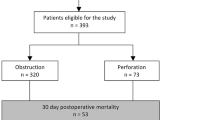Abstract
Purpose
The common causes of colorectal perforation are benign. However, perforated colorectal cancer confers a risk of recurrence in the long term because of the malignant nature of the disease. In addition, the recurrence rate can also increase because of dissemination of cancer cells, reduced extent of lymph node dissection to prioritize saving life, and other reasons.
Methods
We evaluated the clinical features and postoperative recurrence in patients with perforated colorectal cancer who developed general peritonitis and underwent emergency surgery during a 7-year period between April 2007 and March 2014.
Results
During the study period, 44 patients had colorectal cancer perforation. The cancer sites were the ascending colon in 6 patients, transverse colon in 1, descending colon in 4, sigmoid colon in 15, and rectum in 18. The disease stage was stage II in 18 patients, stage III in 15, and stage IV in 7. Among 22 patients who could be followed up, 8 had postoperative recurrence. The recurrence rates were 18.2% for stage II cancer and 54.5% for stage III. Postoperative recurrence was more likely to occur in the patients positive for lymph node metastasis, those with poorly differentiated adenocarcinoma, those with T4 cancer, and those who did not receive postoperative adjuvant chemotherapy.
Conclusion
The recurrence rate was higher in the patients with perforated colorectal cancer than in those who underwent surgery for common colorectal cancer. The prognosis can be expected to improve by performing standard surgical procedures, to the maximum extent possible, followed by postoperative adjuvant chemotherapy.
Similar content being viewed by others
References
Kriwanek S, Armbruster C, Beckerhinn P, Dittrich K (1994) Prognostic factors for survival in colonic perforation. Int J Color Dis 9:158–162
Bielecki K, Kamiński P, Klukowski M (2002) Large bowel perforation: morbidity and mortality. Tech Coloproctol 6:177–182
Biondo S, Parés D, Martí Ragué J, De Oca J, Toral D, Borobia FG, Jaurrieta E (2002) Emergency operations for nondiverticular perforation of the left colon. Am J Surg 183:256–260
Biondo S, Ramos E, Deiros M, Ragué JM, De Oca J, Moreno P, Farran L, Jaurrieta E (2000) Prognostic factors for mortality in left colonic peritonitis: a new scoring system. J Am Coll Surg 191:635–142
Yamamoto T, Kita R, Masui H, Kinoshita H, Sakamoto Y, Okada K, Komori J, Miki A, Uryuhara K, Kobayashi H, Hashida H, Kaihara S, Hosotani R (2015) Prediction of mortality in patients with colorectal perforation based on routinely available parameters: a retrospective study. World J Emerg Surg 10:24. doi:10.1186/s13017-015-0020-y
Khan S, Pawlak SE, Eggenberger JC, Khan S, Pawlak SE, Eggenberger JC, Lee CS, Szilagy EJ, Margolin DA (2001) Acute colonic perforation associated with colorectal cancer. Am Surg 67:261–264
Carraro PG, Segala M, Orlotti C, Tiberio G (1998) Outcome of large-bowel perforation in patients with colorectal cancer. Dis Colon rectum 41:1421–1426
Mandava N, Kumar S, Pizzi WF, Aprile IJ (1996) Perforated colorectal carcinomas. Am J Surg 172:236–238
Harris GJ, Church JM, Senagore AJ et al (2002) Factors affecting local recurrence of colonic adenocarcinoma. Dis Colon rectum 45:1029–1034
Biondo S, Martí-Ragué J, Kreisler E, Parés D, Martín A, Navarro M, Pareja L, Jaurrieta E (2005) A prospective study of outcomes of emergency and elective surgeries for complicated colonic cancer. Am J Surg 189:377–383
Japanese Society for Cancer of the Colon and Rectum (ed.). (2014) JSCCR Guidelines 2014 for the treatment of colorectal cancer. Kanehara, Tokyo
Sobin LH, Gospodarowicz MK, Witterkind CH, eds. (2009) International union against cancer TNM classification of malignant tumors (7th ed.). Wiley-Blackwell, Hoboken, NJ .
Hinchey EJ, PG S, Richards GK (1979) Treatment of perforated diverticular disease of the colon. Adv Surg 12:85–109
Biondo S, Jaurrieta E, Martí Ragué J, Ramos E, Deiros M, Moreno P, Farran L (2000) Role of resection and primary anastomosis of the left colon in the presence of peritonitis. Br J Surg 87:1580–1584
Lee IK, Sung NY, Lee YS, Lee SC, Kang WK, Cho HM, Ahn CH, Lee Do S, Oh ST, Kim JG, Jeon HM, Chang SK (2007) The survival rate and prognostic factors in 26 perforated colorectal cancer patients. Int J Color Dis 22:467–473
Crowder VH Jr, Cohn I Jr (1967) Perforation in cancer of the colon and rectum. Dis Colon rectum 10:415–420
Anwar MA, D’Souza F, Coulter R, Memon B, Khan IM, Memon MA (2006) Outcome of acutely perforated colorectal cancers: experience of a single district general hospital. Surg Oncol 15:91–96
Chen HS, Sheen-Chen SM (2000) Obstruction and perforation in colorectal adenocarcinoma: an analysis of prognosis and current trends. Surgery 127:370–376
Zielinski MD, Merchea A, Heller SF, You YN (2011) Emergency management of perforated colon cancers: how aggressive should we be ? J Gastrointest Surg 15:2232–2238. doi:10.1007/s11605-011-1674-8
Obrand DI, Gordon PH (1997) Incidence and patterns of recurrence following curative resection for colorectal carcinoma. Dis Colon rectum 40:15–24
Goligher JC, Smiddy FG (1957) The treatment of acute obstruction or perforation with carcinoma of the colon and rectum. Br J Surg 45:270–274
Minster JJ (1964) Comparison of obstructing and nonobstructing carcinoma of the colon. Cancer 17:242–247
Teixeira F, Akaishi EH, Ushinohama AZ, Dutra TC, Netto SD, Utiyama EM, Bernini CO, Rasslan S (2015) Can we respect the principles of oncologic resection in an emergency surgery to treat colon cancer? World J Emerg Surg. doi:10.1186/1749-7922-10-5
Hirose H, Miyazaki S, Fujita S, Miyazaki Y, Sugimoto S, Michiura T, Yamabe K, Nagaoka M (2014) Clinical outcome of 13 patients with perforated colorectal cancer. Jpn j cancer chemother 41:1728–1730
Author information
Authors and Affiliations
Corresponding author
Ethics declarations
Conflict of interest
The authors declare that they have no conflict of interest.
Ethical approval
This study was approved by the institutional review board of our university (15076).
Rights and permissions
About this article
Cite this article
Asano, H., Kojima, K., Ogino, N. et al. Postoperative recurrence and risk factors of colorectal cancer perforation. Int J Colorectal Dis 32, 419–424 (2017). https://doi.org/10.1007/s00384-016-2694-3
Accepted:
Published:
Issue Date:
DOI: https://doi.org/10.1007/s00384-016-2694-3




